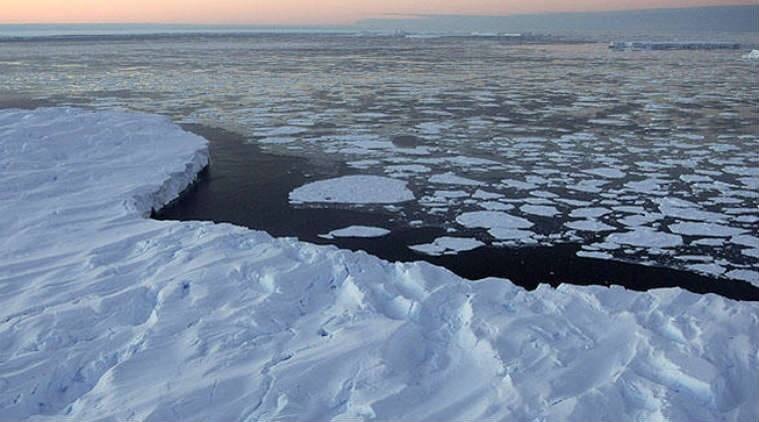The regular pattern of weather conditions of a particular place is called as climate of that place. This regular pattern of weather conditions is considerably disturbed by fluctuations in temperature. The disturbance in the pattern of weather conditions at the particular place may thus be called as Climate Change.
The Global Warming itself is not the Climate Change as the effects of global warming may not be uniformly negative. But, it is the abnormal rise in global temperature that is causing changes in the global climate. Let us see, how abnormal changes in temperature may lead to climate change.
Temperature has significant role in the regulation of water cycle in the environment. Hence, rise in global temperature can change the pattern of water cycle. On the other hand, increased temperature can cause most of the ice to melt down. The increased evaporation of water due to high temperature may alter the pattern of cloud formation and rains at different places.
The physical features of the earth also play important roles in causing temperature variations that finally result into variations in air pressures. These variations cause disastrous conditions like storms, cyclones, tornadoes and hurricanes etc.
International agencies studying the climate change have projected the globally averaged temperature to increase by 1.4 to 5.8 degrees Celsius over the period 1990 to 2100.The Intergovernmental Panel on Climate Change (IPCC) does important climatic researches and surveys on periodic basis. It has hundreds of scientists from many different countries that study and analyze the meteorological changes and provide a collective pictures of global warming and other changes in the climate systems.
About two thousand leading scientists of the world got assembled in 1995 to discuss and decide about the Global Warming. These scientists, discussing and deciding under the banner of Intergovernmental Panel on Climate Change (IPCC), came to the conclusion that the global warming was real, serious and accelerating.
Intergovernmental Panel on Climate Change (IPCC) predicted that the earth’s average temperature could rise further by 1.4 to 5.8 Celsius degrees within next 100 years. It may cause serious changes in weather pattern that may surely endanger our lives, our agriculture, and our plants as well as our animals.
Any adverse change in the weather pattern or in the environment on the whole, is sure to affect adversely the lives of human beings. We can easily understand that a warmer climate is sure to change the patterns of rain fall and snow fall. It is sure to cause increases in the frequency and severity of drought and floods also.
The increasing heat will cause the air to expand and develop more capacity of holding moisture. In turn, this is sure to affect our resources like water, forests, and different ecological systems. These conditions will affect the conditions of power generation, infrastructure, tourism and healthy living.
The changes intemperature have already caused a number of disasters like cyclones, hurricanes, and other forms of storms across the world. In a nut shell we may conclude that changing climate due to the global warming will damage natural resources, together with causing spread of deadly diseases, displacement of human populations, hunger, loss of economy and shortage of human resources, in case the problem of global warming is not averted properly.
The Global Warming has various types of impacts on the whole earth, its systems and the whole human society. Global Warming may cause frequent natural disasters like cyclones, storms and hurricanes, floods and droughts. Thus it may claim lives of large sections of human society. It may also cause cloud bursts, avalanches, landslides, mud- flows and earthquakes. A very large number of men, women and children are killed in these disasters. Thousands of people become homeless and migrate elsewhere to take shelter as refugees.
Global Warming is causing melting of ice and glaciers which is leading to a rise in sea- level. As a result, the creeping up oceans swallow low laying islands, coastal areas, people and their property etc. Such was the case of SATBHAYA village of Orissa State of India.
According to the fourth assessment Report, Brussels, April 2007 of Intergovernmental Panel on Climate Change (IPCC), the Global Warming Induced Climate Change causes following adverse impacts on human health –
- Increases in malnutrition and consequent disorders, with implication for child growth and development;
- Increased deaths, diseases and injury due to heat waves, floods, storms, fires and droughts;
- The increased burden of diarrheal diseases;
- Increased frequency of cardio-respiratory diseases due to higher concentrations of ground level ozone related to climate change; and
- The altered spatial distribution of vectors of some diseases.
Global Warming has wide ranging effects on many aspects of human life. It threatens economies, lives and traditions. In the U.S.A., Chicago experienced one of the worst weather related disasters in Illinois history when a heat wave resulted in 525 deaths during 5 day period in July of 1995.
A warmer climate can expand the geographic range of tropical mosquito borne diseases such as Malaria, dengue fever, yellow fever etc. to higher altitudes and the maturation of certain disease causing agents and their vectors.
India was hit by a severe heat wave in 2003. Temperature reached as high as 50 Celsius degrees in May across the worst hit areas and over 1200 people died. Just 5 years earlier, the most disastrous heat wave that hit India during April- June 1998 with an estimated fatalities 3028. The temperature rose as higher as 45 to 49.80 Celsius degrees in several Indian states.
The human caused global warming may have already doubled the chance of killer heat waves like the one that scorched Europe in July- August2003. The summer was hottest in Europe in July –August 2003. That summer was hottest in Europe in at least last 5000 years.
The rising sea level is causing loss of land, loss of property and loss of lives. It may also cause large scale displacement of people which may further create a problem of rehabilitation.
The rising temperature due to global warming has melted down the ice of a number of glaciers. The total surface of glaciers worldwide has decreased by 50 per cent since the end of 19th century.
According to a report, the snow cap that covered Mountain Kilimanjaro, the highest mountain of Africa, since last 11000 years, i.e. since the last ice age, was about to disappear up to March 2005.
The ice caps of this mountain that gave it the name of the Shining Mountain are no longer shining now. Fascinated by its shining appearance, the famous author Ernest Hemmingway wrote his classic ‘The Snows of Kilimanjaro”. But about 80 per cent of its snow has vanished now, since 1912.
Feature Image :https://indianexpress.com/




